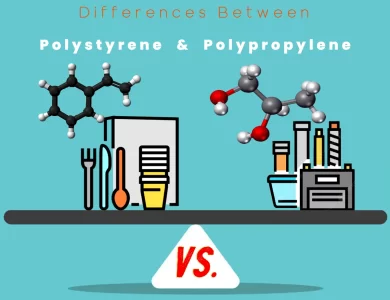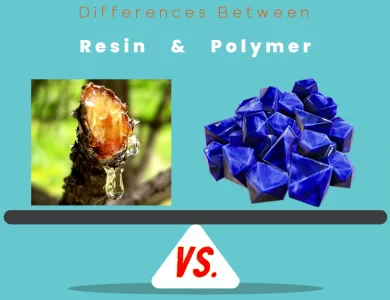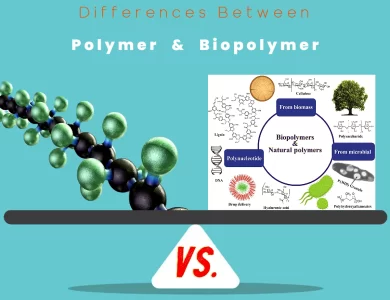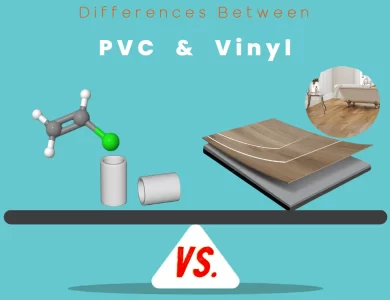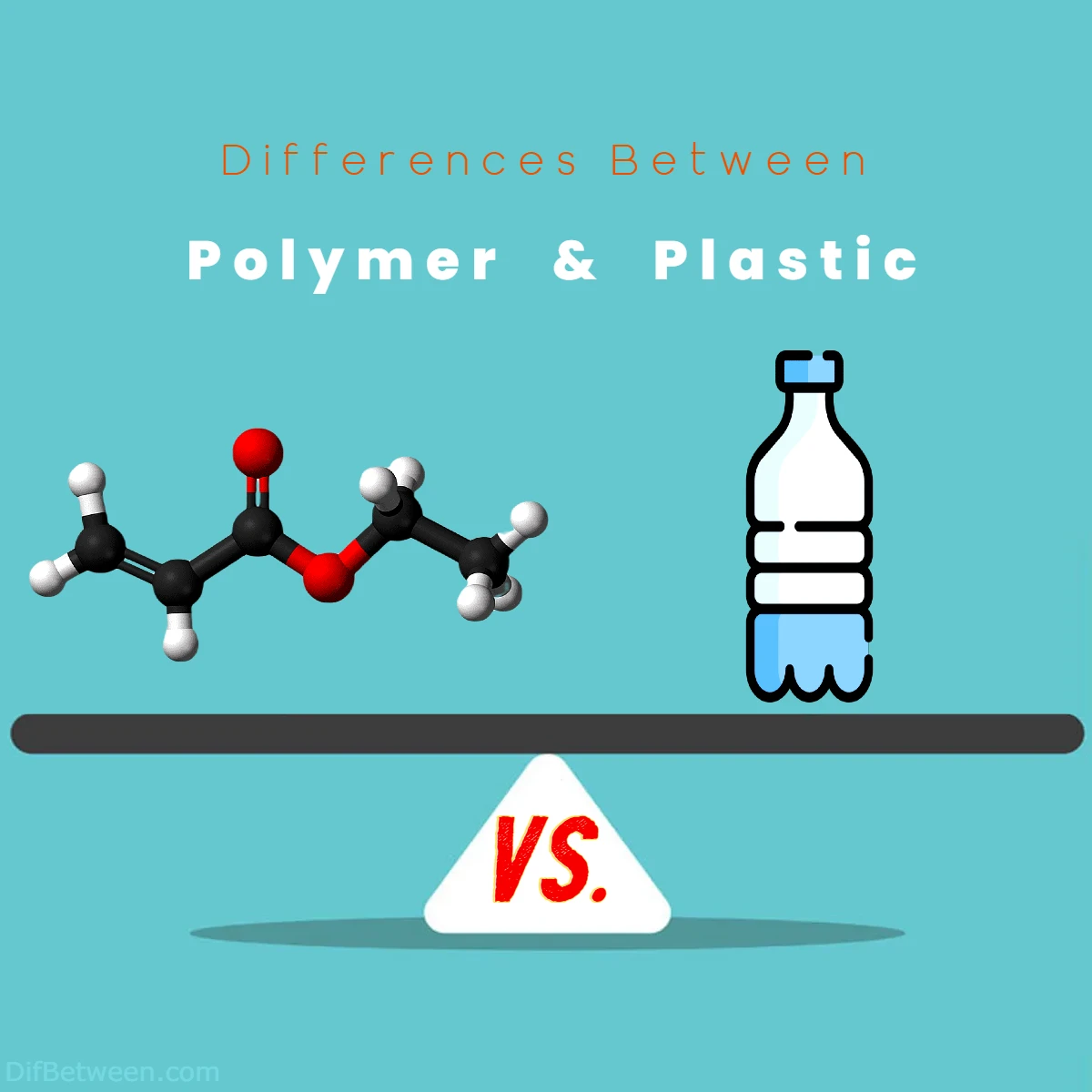
| Aspect | Polymers | Plastics |
|---|---|---|
| Composition | Large molecules composed of repeating structural units, which can be natural or synthetic. | A subset of synthetic polymers that are moldable when subjected to heat or pressure, typically derived from petrochemicals. |
| Natural vs. Synthetic | Includes both natural polymers (e.g., cellulose, proteins) and synthetic polymers (e.g., polyethylene, PVC). | Primarily synthetic materials, although some biodegradable plastics are derived from renewable resources. |
| Chemical Bonding | Monomers are chemically bonded to form long chains or networks. | Monomers are chemically bonded to create a polymer with specific properties. |
| Examples | Natural polymers: Cellulose, proteins, rubber. Synthetic polymers: Polyethylene, PVC, polypropylene. | Polyethylene, polypropylene, PVC, PET, polystyrene, etc. |
| Elasticity and Strength | Variable elasticity and strength depending on the type of polymer. Can be flexible, elastic, or rigid. | Elasticity and strength depend on the type of plastic and its chemical composition. Some plastics are flexible, while others are rigid. |
| Thermal Properties | Melting points and thermal stability vary widely among different polymers. | Plastics have varying melting points and thermal stability, depending on their chemical makeup. |
| Transparency | Polymers can be transparent (e.g., polyethylene), translucent (e.g., polypropylene), or opaque (e.g., PVC). | Plastics can be transparent (e.g., PET), translucent (e.g., polypropylene), or opaque (e.g., polystyrene). |
| Chemical Resistance | Chemical resistance varies among polymers. Some are highly resistant to chemicals, while others are not. | Some plastics, like PVC, are known for their chemical resistance, while others may be susceptible to chemical degradation. |
| Moldability | Polymers are not inherently moldable but can be processed into moldable forms (e.g., thermoplastics). | Plastics are inherently moldable when subjected to heat or pressure, making them versatile for manufacturing processes like injection molding. |
| Recyclability | Recyclability varies among polymers. Some are readily recyclable, while others are challenging to recycle. | Plastic recycling is common, with specific types (e.g., PET, HDPE) being more easily recycled than others. |
| Environmental Impact | Impact depends on the type of polymer. Natural polymers tend to be biodegradable and eco-friendly. Synthetic polymers can be non-biodegradable and environmentally problematic. | Plastics have raised environmental concerns due to the persistence of traditional plastics. Biodegradable plastics and recycling initiatives aim to reduce their impact. |
| Applications | Widely used in medical, textile, construction, automotive, and electronics industries, among others. | Commonly used in packaging, consumer goods, agriculture, medical devices, transportation, and more. |
| Sustainability Initiatives | Efforts to develop biodegradable synthetic polymers, improve recycling, and promote green chemistry. | Focus on biodegradable plastics, closed-loop recycling, reducing single-use plastics, and exploring alternative materials. |
As we traverse the landscapes of polymers and plastics, you’ll gain insights into their composition, properties, applications, and environmental implications. We’ll unveil the secrets of these versatile materials, exploring the diverse worlds they inhabit, from the medical marvels of polymers to the ubiquitous presence of plastics in our daily lives. And with each revelation, you’ll be one step closer to becoming a discerning advocate for sustainable solutions in a world where choices matter more than ever.
Differences Between Polymer and Plastic
The main differences between Polymer vs Plastic lie in their composition and applications. Polymers encompass a broader category, including both natural and synthetic materials, with varying levels of biodegradability. In contrast, plastics are a subset of synthetic polymers known for their moldability when subjected to heat or pressure, often derived from petrochemicals. Plastics find widespread use in packaging, consumer goods, and beyond, while polymers span a diverse range of industries, from medical to construction, with natural polymers offering more eco-friendly options. Understanding these distinctions is essential in making informed choices about material usage in an increasingly environmentally conscious world.
Composition and Structure
Polymers
Polymers are a broad class of materials characterized by their large molecules composed of repeating structural units, also known as monomers. These monomers are linked together through chemical bonds, forming a long chain-like structure. The repeating units can be simple or complex, and they determine the material’s properties. Polymers can be natural or synthetic, and they encompass a wide range of substances, including proteins, DNA, and synthetic plastics.
| Type of Polymer | Natural Source |
|---|---|
| Protein | Animal and plant cells |
| Cellulose | Plant cell walls |
| DNA | Genetic material |
| Rubber | Latex from rubber trees |
| Type of Polymer | Common Applications |
|---|---|
| Polyethylene | Plastic bags, bottles |
| Polypropylene | Packaging, automotive parts |
| Polyvinyl chloride | PVC pipes, vinyl flooring |
| Polystyrene | Foam cups, packaging |
Plastics
Plastics, on the other hand, are a subset of polymers. They are synthetic polymers that are moldable when subjected to heat or pressure. Plastics are typically made from petrochemicals, such as petroleum or natural gas, through a process called polymerization. During polymerization, monomers are chemically bonded together to create a polymer with specific properties.
| Type of Plastic | Abbreviation | Common Uses |
|---|---|---|
| Polyethylene | PE | Plastic bags, bottles, toys |
| Polypropylene | PP | Packaging, automotive parts |
| Polyvinyl chloride | PVC | Pipes, vinyl flooring, clothing |
| Polystyrene | PS | Foam cups, packaging |
| Polyethylene terephthalate | PET | Beverage bottles, polyester |
| Polycarbonate | PC | Eyewear lenses, CDs, bottles |
Properties
Polymers
Polymers exhibit a wide range of properties depending on their chemical structure and the types of monomers involved. Some common characteristics of polymers include:
- Flexibility: Polymers can be flexible and elastic, like rubber, or rigid, like some plastics. The arrangement of the polymer chains determines this property.
- Strength: The strength of a polymer depends on the forces holding its chains together. Some polymers, like Kevlar, are exceptionally strong and are used in applications requiring high tensile strength.
- Thermal Properties: Polymers have varying melting points and thermal stability. Some can withstand high temperatures, while others soften or melt at relatively low temperatures.
- Transparency: Polymers can be transparent, translucent, or opaque, depending on their molecular arrangement. For example, polyethylene is translucent, while polypropylene is relatively opaque.
- Chemical Resistance: Polymers can be resistant to chemicals, making them suitable for applications where exposure to corrosive substances is a concern. For instance, polyvinyl chloride (PVC) is known for its chemical resistance.
Plastics
Plastics, being a subset of polymers, share many properties with polymers in general. However, they also have some unique characteristics:
- Moldability: Plastics can be molded into various shapes when heated, which makes them versatile for manufacturing processes like injection molding, extrusion, and thermoforming.
- Lightweight: Many plastics are lightweight, which is advantageous in applications where weight is a critical factor, such as automotive and aerospace industries.
- Insulation: Plastics are often used as electrical insulators due to their low electrical conductivity. This property is essential in wiring and electronic applications.
- Durability: Plastics can be engineered to be highly durable, resisting wear and tear, UV radiation, and harsh environmental conditions.
- Biodegradability: While some plastics are not biodegradable and pose environmental concerns, there are biodegradable plastics designed to break down more easily, reducing their ecological impact.
Applications
Polymers
Polymers, both natural and synthetic, find applications in a wide range of industries and products:
- Medical: Biocompatible polymers like polyethylene and polyurethane are used in medical devices, implants, and drug delivery systems.
- Textiles: Synthetic polymers like polyester and nylon are commonly used in the textile industry to make clothing, fabrics, and carpets.
- Construction: Polymers like polyvinyl chloride (PVC) and acrylics are used for pipes, windows, and insulation in the construction industry.
- Automotive: Polymers are used in various automotive components, including dashboards, bumpers, and tires.
- Electronics: Polymers are used for insulation, circuit boards, and protective coatings in electronic devices.
Plastics
Plastics have a vast array of applications across industries due to their moldability and versatility:
- Packaging: Plastics are widely used for packaging materials such as bottles, containers, and films due to their lightweight and protective properties.
- Consumer Goods: Plastic is used in everyday items like toys, kitchenware, and furniture.
- Agriculture: Plastic is used for agricultural purposes, including mulch films, irrigation pipes, and greenhouse coverings.
- Medical: Medical plastics are used in syringes, IV bags, and medical equipment housing.
- Transportation: Plastics are used in the automotive and aerospace industries for lightweight components that enhance fuel efficiency.
Environmental Impact
Polymers
The environmental impact of polymers varies depending on their source and how they are used. Natural polymers, like cellulose and proteins, are generally biodegradable and less harmful to the environment. However, synthetic polymers, including some plastics, can have a more significant environmental footprint:
- Non-Biodegradable: Many synthetic polymers, especially traditional plastics like polyethylene and polypropylene, are non-biodegradable, leading to long-lasting waste in landfills and oceans.
- Microplastic Pollution: When synthetic polymers break down into smaller particles, they contribute to the growing problem of microplastic pollution in water bodies.
- Energy Intensive: The production of synthetic polymers, including plastics, often requires significant energy inputs and generates greenhouse gas emissions.
Plastics
Plastics have received considerable attention regarding their environmental impact, leading to efforts to mitigate their negative effects:
- Recycling: Recycling programs aim to reduce the amount of plastic waste by reusing and repurposing materials. Commonly recycled plastics include PET and HDPE.
- Biodegradable Plastics: Some biodegradable plastics are designed to break down more quickly than traditional plastics, reducing their persistence in the environment.
- Alternative Materials: Researchers are exploring alternative materials to traditional plastics, such as bioplastics made from renewable resources like cornstarch and sugarcane.
- Reducing Single-Use Plastics: Many governments and businesses are taking steps to reduce the use of single-use plastics, such as banning plastic bags and straws.
Mechanical Properties
Polymers
Polymers exhibit various mechanical properties, making them suitable for a wide range of applications:
- Elasticity: Some polymers, like rubber, are highly elastic, returning to their original shape after deformation. This property is essential in applications such as tires and seals.
- Tensile Strength: The tensile strength of polymers varies widely. While materials like nylon and Kevlar are known for their high tensile strength, others may be more brittle and have lower tensile strength.
- Hardness: Polymers can range from very soft to extremely hard, depending on their composition and cross-linking. For instance, polyurethane can be soft like foam or hard like a plastic.
- Impact Resistance: Polymers like polycarbonate are known for their exceptional impact resistance, making them suitable for applications like bulletproof glass and safety goggles.
Plastics
Plastics, as a subset of polymers, inherit many of these mechanical properties. However, their moldability and processing techniques can influence their mechanical characteristics:
- Ductility: Plastics can be highly ductile, which means they can be stretched into various shapes without breaking. This property is exploited in processes like thermoforming.
- Brittleness: While some plastics are ductile, others can be brittle. Understanding a plastic’s brittleness is crucial in designing products that need to withstand impacts or loads.
- Flexural Strength: Plastics can have significant flexural strength, which is vital in applications where bending or deformation under load is a concern, such as in structural components.
- Creep Resistance: Plastics can experience creep, a slow, time-dependent deformation under a constant load. Creep resistance is essential in applications where long-term stability is required.
Processing Methods
Polymers
Polymers can be processed using various techniques, depending on their properties and intended applications:
- Extrusion: This process involves forcing a polymer through a die to create continuous shapes, such as pipes, tubing, and profiles.
- Injection Molding: Injection molding is used to produce complex and precise plastic parts by injecting molten polymer into a mold cavity.
- Blow Molding: This method is commonly used for producing hollow objects like bottles. A parison (hollow tube) of molten plastic is inflated inside a mold.
- Compression Molding: Compression molding is ideal for manufacturing products with intricate shapes, such as automotive parts and electrical insulators.
Plastics
Plastics benefit from a wide range of processing methods due to their ability to be molded:
- Thermoforming: Thermoforming involves heating a plastic sheet and then using a mold to shape it while it’s in a softened state. It’s commonly used for packaging, trays, and disposable utensils.
- Rotational Molding: In this process, powdered plastic is placed in a mold, which is then rotated in an oven. The plastic powder melts and coats the inside of the mold, creating hollow objects like tanks and playground equipment.
- Film Blowing: Film blowing is used to produce plastic films and sheets. Molten plastic is extruded through a circular die, and air is used to inflate it into a bubble, which is then flattened and cooled.
- Vacuum Forming: Similar to thermoforming, vacuum forming uses suction to draw a heated plastic sheet over a mold. It’s commonly used for producing packaging and signage.
The Future of Sustainable Alternatives
Polymers
Sustainability is a growing concern in the world of polymers, especially for synthetic polymers. Researchers and manufacturers are exploring ways to make polymers more environmentally friendly:
- Biodegradable Polymers: Development continues on biodegradable polymers that break down more readily in the environment, reducing the long-term impact of plastics.
- Recycling: Improving recycling processes and increasing the use of recycled materials in polymer production is a key focus to reduce the demand for new resources.
- Green Chemistry: Innovations in green chemistry aim to develop polymers using more sustainable and renewable feedstocks.
Plastics
Plastics, being a subset of polymers, share these sustainability challenges and solutions. In addition to the efforts mentioned earlier, there are specific initiatives within the plastic industry:
- Bioplastics: Bioplastics made from renewable resources like cornstarch, sugarcane, and algae are gaining traction as eco-friendly alternatives.
- Closed-Loop Recycling: Some companies are implementing closed-loop recycling systems where plastics are collected, processed, and reused within a controlled cycle, minimizing waste.
- Reducing Single-Use Plastics: Governments and organizations worldwide are taking measures to reduce single-use plastic items like bags, straws, and utensils.
- Alternative Materials: Researchers are exploring materials beyond traditional plastics, such as mushroom-based packaging and edible packaging, to further reduce environmental impact.
Polymer or Plastic: Which One is Right Choose for You?
In the world of materials, the choice between polymers and plastics can be a pivotal decision. Whether you’re an engineer designing a new product, a consumer looking for eco-friendly options, or simply curious about the materials that surround us, understanding the nuances between polymers and plastics is crucial. In this guide, we’ll help you navigate the choice between these two materials, considering factors such as sustainability, applications, and practicality.
Sustainability: A Key Consideration
Polymers
Polymers encompass a broad category of materials, including both natural and synthetic varieties. When it comes to sustainability, the impact of polymers can vary significantly:
- Natural Polymers: Materials like cellulose (from plant cell walls) and proteins (found in animal and plant cells) are naturally occurring and often biodegradable. They can be environmentally friendly choices for various applications.
- Synthetic Polymers: Many synthetic polymers, such as traditional plastics like polyethylene and polypropylene, are not biodegradable and can persist in the environment for extended periods. However, efforts are underway to develop biodegradable synthetic polymers and enhance recycling.
Plastics
Plastics, being a subset of synthetic polymers, are at the center of sustainability discussions:
- Traditional Plastics: Conventional plastics, like those used in single-use items such as plastic bags and packaging, have raised environmental concerns due to their persistence and contribution to pollution.
- Bioplastics: Biodegradable plastics, often derived from renewable sources like cornstarch or sugarcane, offer a more sustainable alternative. They break down more easily in the environment, reducing long-term impact.
- Recycling: Recycling programs aim to reduce the environmental footprint of plastics by reusing and repurposing materials. Some plastics, like PET and HDPE, are commonly recycled.
Practicality in Applications
Polymers
Polymers, with their diverse range of materials, find applications in various industries and products:
- Medical: Biocompatible polymers like polyethylene and polyurethane are used in medical devices, implants, and drug delivery systems.
- Textiles: Synthetic polymers like polyester and nylon are widely used in clothing, fabrics, and carpets.
- Construction: Polymers like polyvinyl chloride (PVC) and acrylics are used for pipes, windows, and insulation in the construction industry.
- Automotive: Polymers are used in various automotive components, including dashboards, bumpers, and tires.
Plastics
Plastics, being highly moldable, have diverse applications across industries:
- Packaging: Plastics are widely used for packaging materials such as bottles, containers, and films due to their lightweight and protective properties.
- Consumer Goods: Plastic is used in everyday items like toys, kitchenware, and furniture.
- Agriculture: Plastic is used for agricultural purposes, including mulch films, irrigation pipes, and greenhouse coverings.
- Medical: Medical plastics are used in syringes, IV bags, and medical equipment housing.
Biodegradability and Environmental Impact
Polymers
- Natural Polymers: Many natural polymers, such as cellulose and proteins, are biodegradable and have a lower environmental impact.
- Synthetic Polymers: Synthetic polymers can vary in biodegradability. Traditional plastics often persist in the environment, while biodegradable synthetic polymers are designed to break down more readily.
Plastics
- Traditional Plastics: Conventional plastics are known for their long-lasting environmental impact, contributing to issues like plastic pollution and microplastic contamination.
- Biodegradable Plastics: Biodegradable plastics are engineered to decompose more quickly, reducing their ecological footprint. However, their effectiveness depends on specific conditions, such as temperature and moisture.
Making the Right Choice
In the choice between polymers and plastics, several factors come into play. Here are some key considerations to help you make an informed decision:
- Application: Consider the specific requirements of your project or product. Polymers may be more suitable for certain applications, while plastics, with their moldability, may be a better fit for others.
- Sustainability: Evaluate the environmental impact of your choice. If sustainability is a priority, explore options like biodegradable plastics or natural polymers.
- Regulations: Be aware of local regulations and restrictions on certain materials, especially when it comes to single-use plastics.
- Recycling: If recycling is a concern, choose plastics that are commonly recycled in your region.
- Longevity: Consider the expected lifespan of your product. In some cases, durable plastics may be more appropriate, while biodegradable options may be preferred for short-term use.
- Cost: Assess the cost-effectiveness of your choice, taking into account production, recycling, and disposal costs.
FAQs
The primary difference lies in their categorization: polymers encompass a broader range, including natural and synthetic materials, while plastics are a subset of synthetic polymers, specifically chosen for their moldability.
No, not all polymers are biodegradable. Natural polymers like cellulose and proteins are often biodegradable, but many synthetic polymers, including traditional plastics, are not.
Yes, plastics can be recycled. Some types of plastics, such as PET and HDPE, are more readily recyclable than others, contributing to sustainability efforts.
Polymers are versatile and find applications in various industries, including medical devices, textiles, construction materials, automotive components, and electronics.
Traditional plastics are known for their long-lasting environmental impact, contributing to issues like plastic pollution. However, efforts are underway to develop biodegradable plastics and enhance recycling to reduce this impact.
Yes, eco-friendly alternatives include biodegradable plastics derived from renewable sources, closed-loop recycling systems, and exploring alternative materials like mushroom-based packaging and edible packaging.
Yes, polymers can be transparent (e.g., polyethylene), translucent (e.g., polypropylene), or opaque (e.g., PVC), depending on their molecular arrangement.
The future holds promise for more sustainable options, with ongoing research in biodegradable materials, recycling, and reducing the use of single-use plastics, fostering a more environmentally responsible industry.
Consider factors like the application’s requirements, sustainability goals, regulations, recyclability, expected product lifespan, and cost-effectiveness to make an informed choice between polymers and plastics for your project.
Read More:
Contents
